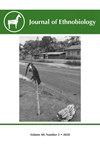寂静之声:达喀尔海岸线上鱼叉渔民生态知识的沉浸式探索
IF 1.3
3区 社会学
Q1 ANTHROPOLOGY
引用次数: 0
摘要
在感觉人类学和水下生物声学的十字路口,本文提供了一种身临其境的方法来获取达喀尔水下渔民的知识和看法。四名塞内加尔渔民通过对七次潜水的描述和评论,传达了他们对城市周边水下环境的丰富知识。他们使用的相机配备了一个集成麦克风,连接在头上,专注于海洋声景。这种方法的目的是记录他们对达喀尔水下海洋环境的生态知识,包括它的发展、海岸线的变化和水下城市扩展,如下水道、水面排水和各种排放物。诸如“客”鱼或“社会”鱼等概念被潜水员用来描述鱼类的行为,突出了评估不同物种可捕获性的要素。文中叙述了达喀尔海岸对洄游鱼类吸引力的下降,这与城市污染排放、水下生境的破坏以及水肺潜水和夜间狩猎活动的发展有关。总的来说,收集到的资料使人们对与全球变暖的全球范围和过度开发的问题有关的变化有了正确的认识。本文章由计算机程序翻译,如有差异,请以英文原文为准。
The Sound of Silence: An Immersive Approach to Spearfishermen's Ecological Knowledge Along the Dakar Coastline
At the crossroads of sensory anthropology and underwater bioacoustics, this article offers an immersive approach to garner the knowledge and perceptions of Dakar underwater fishermen. Four Senegalese fishermen conveyed their extensive knowledge of the peri-urban underwater environment through the descriptions of and commentaries on the seven dives they recorded using a camera equipped with an integrated microphone attached to their heads that focused on the marine soundscape. This methodology was aimed at documenting their ecological knowledge of the underwater marine environment of Dakar concerning its growth, the modifications of the shoreline, and underwater urban extensions such as sewers, water drainage from the surface and various discharges. Notions such as “guest” fish or “social” fish, among others, are used by divers to describe the behavior of fish, highlighting the elements that allow assessing the catchability of different species. A decrease in the attractiveness of the Dakar coast for migratory fish is described in connection with urban pollution discharges, the destruction of underwater habitats, and the development of scuba-diving and night-hunting practices. In general, the information collected puts into perspective the changes perceived both in connection with the worldwide scale of global warming and the problems of over-exploitation.
求助全文
通过发布文献求助,成功后即可免费获取论文全文。
去求助
来源期刊

Journal of Ethnobiology
Social Sciences-Anthropology
CiteScore
4.80
自引率
3.40%
发文量
21
审稿时长
>12 weeks
期刊介绍:
JoE’s readership is as wide and diverse as ethnobiology itself, with readers spanning from both the natural and social sciences. Not surprisingly, a glance at the papers published in the Journal reveals the depth and breadth of topics, extending from studies in archaeology and the origins of agriculture, to folk classification systems, to food composition, plants, birds, mammals, fungi and everything in between.
Research areas published in JoE include but are not limited to neo- and paleo-ethnobiology, zooarchaeology, ethnobotany, ethnozoology, ethnopharmacology, ethnoecology, linguistic ethnobiology, human paleoecology, and many other related fields of study within anthropology and biology, such as taxonomy, conservation biology, ethnography, political ecology, and cognitive and cultural anthropology.
JoE does not limit itself to a single perspective, approach or discipline, but seeks to represent the full spectrum and wide diversity of the field of ethnobiology, including cognitive, symbolic, linguistic, ecological, and economic aspects of human interactions with our living world. Articles that significantly advance ethnobiological theory and/or methodology are particularly welcome, as well as studies bridging across disciplines and knowledge systems. JoE does not publish uncontextualized data such as species lists; appropriate submissions must elaborate on the ethnobiological context of findings.
 求助内容:
求助内容: 应助结果提醒方式:
应助结果提醒方式:


